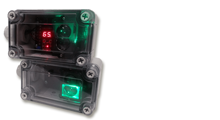Demand controlled ventilation
Tuesday, 04. August 2020
How demand control ventilation impacts bottom lines |
||||||||||||||
| Particles in the air have a far-reaching effect - A variety of industrial and non-industrial environments are subject to air quality concerns due to the buildup of particulate matter (PM). This includes anything from dust and pollen to smoke and even potentially harmful organisms. In fact, for every one particle that is visible to the human eye, there are more than ONE MILLION PARTICLES THAT ARE NOT. However, over time, these particles can pose a threat to worker safety and overall air quality. This is why demand control ventilation sensors are a necessity in every production environment. |
||||||||||||||
|
|
||||||||||||||
 |
||||||||||||||
| Many air quality reports will detail the amount of particulate matter present in an environment using PM 2.5 readings. This details the amount of particulate matter present with a diameter less than 2.5 micrometers, or roughly three percent of the diameter of a single piece of human hair. These fine particles can only be seen with a microscope. The reason they are so dangerous is that their size and lightness allow them to remain suspended in the air and enter the lungs by bypassing the nose and throat during inhalation. Short- and long-term exposure to particulate matter IS SHOWN TO RESULT in various forms of lung and heart disease. While there are different types of demand control ventilation equipment, one of the most important is the sensor used to detect changes in light transmission. This device monitors the increase or decrease in particulate matter to send a signal for another operation to activate, such as ventilation. Here, we’ll explore a few applications where demand control ventilation sensors are put to use and what this process helps to achieve long-term. THREE ENVIRONMENTS WHERE DEMAND CONTROL VENTILATION MAKES A DIFFERENCE 1. COMMERCIAL KITCHENS Restaurants and non-residential kitchens around the world operate for hours on end, generating a significant amount of smoke depending on the amount of food being cooked. While building ventilation systems are active throughout the day, the hood ventilation unit can be connected to demand control ventilation sensors to adjust speed based on the amount of smoke detected. If this equipment were not present, the ventilation unit might run all day, increasing energy consumption and operating costs. Thanks to the particulate monitoring sensor measuring smoke density in the cooking space, the speed of the ventilation hood fan can be regulated dynamically based on demand. This process is also called demand control kitchen ventilation (DCKV). 2. MANUFACTURING FACILITIES Virtually every manufacturing facility is producing fine particles 24/7/365 as a natural result of their work. From the machines producing goods to the people and vehicles transporting and picking items in warehouses, air quality can be quite challenging to control, and yet manufacturers and distributors are required to provide a safe working environment. With demand control ventilation sensors, companies can not only help to remove potentially dangerous particles in the air, but also create long-term savings. Similar to commercial kitchens, a properly implemented particulate monitor sensor that measures light transmission can help regulate ventilation systems. This ensures that the airborne particulate matter within the facility never goes above a certain level. It also ensures that ventilation keeps up with production, so periods of greater demand (and thus higher levels of particulate matter in the air) can be addressed with greater ventilation capacity. 3. ENVIRONMENTAL MONITORING People typically spend 80–90 PERCENT OF THEIR TIME indoors for work and leisure. Because of this, indoor air quality (IAQ) is of great concern to the Environmental Protection Agency. Offices and large buildings can potentially pose threats to the safety of occupants, particularly if they are older or their ventilation systems don’t adequately source air from outdoors. In these instances, demand control ventilation sensors are a necessity. While industrial environments tend to produce more readily-visible particulate matter due to their nature, commercial environments can collect matter brought in from outdoors, generated through various activities, construction or remodeling that may be going on inside, and other reasons. For these reasons, a fine-tuned sensor that allows for a more precise measurement of light transmission would help to regulate ventilation systems and ensure the safety and comfort of those inside the facility. GET A CLEARER PICTURE OF YOUR AIR QUALITY Whether you’re in an industrial or commercial environment, the quality of your air is critical to the safety of your team. With the proper particulate monitor sensor, you can help to improve air quality while also benefiting from reduced energy costs and greater longevity in HVAC systems due to more precise regulation. The PMX PARTICULATE MONITOR FROM EMX INDUSTRIES, INC. is the sensor you need to achieve these key results. The PMX particulate monitor features 99 levels of relative light transmission, allowing you to establish the appropriate threshold and monitor with extreme precision. It offers rapid detection speed thanks to its 100-microsecond discrete output response and can measure light transmission up to 30 feet between the transmitter and receiver. The unit is available in two configurations based on your needs: board only for integration into OEM equipment and in NEMA 4X housings for applications requiring a sealed enclosure. |
||||||||||||||
Products and series for this article |
||||||||||||||
|
||||||||||||||
| Original text from our partner EMX Industries Inc. Click here for the original article | ||||||||||||||



